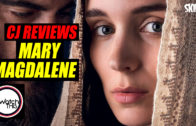I was seriously sceptical about Mary Magdalene; I was bemused and confused as to why Garth Davis should choose it as his ‘blank check’ movie following his incredible debut with Lion; I’m not a follower of Christ; and the poster was less than inspiring. I worried – call me cynical – that Davis was either making a play for a gazillion dollars at the faith-based box office, or for Rooney Mara (who played the very lacklustre role of Lucy, ‘the girlfriend’, in Lion). The poster implied that he could be having a shot at both. Faith-based movies continue to over-perform at the (American) box office, and there’s a long history of directors falling for actresses in supporting roles in their big debut films and then essentially devoting their next film to shooting them in close-up.
Davis certainly does the latter. It feels like a third of the screen time is spent on Mara’s face. And not speaking: people rarely speak in Mary Magdalene; it is a film of very little dialogue, almost entirely made of mood. But the mood it makes… well, it’s pretty magical. Davis, his production designer Fiona Crombie, his cinematographer Greig Fraser, and, perhaps most importantly, his composers Hildur Guonadottir and Johann Johannsson (whose contribution here represents his final work; he died earlier this year), whose intense, spooky score gives the bulk of the film an oppressive sense of dire impending menace and doom.
Oppressive, but appropriate, because Christ – extremely convincingly, and somehow originally, played by Joaquin Phoenix – knows he’s going to die, and his apostles do too. But it’s also because Christ – as portrayed here – is spooky. This is the first film I’ve seen to truly depict how scary it would be to see someone restore someone’s blindness, let alone bring someone back from the dead. Those scenes, here, colour the entire rest of the film, and, for once, allow the viewer to appreciate just why these apostles are so willing to follow this somewhat berserk, very dusty beardy weirdie through the desert.
The film makes brilliant use of dramatic ellipsis. We experience the story of Christ through Mary Magdalene’s eyes, meaning we don’t see what she doesn’t. Thus, we’re spared all the whipping and other torture so lavishly laid on in Mel Gibson’s The Passion Of The Christ (and most other New Testament adaptations). Davis’ version has her at Christ’s final hours, and, as has become recognised theological canon, his resurrection, but there’s no Herod, no Pilate; indeed, barely any Romans at all.
That’s all the good stuff. The frustrating thorn is that the film may as well have been called Judas or Peter. Mary is a completely passive lead character (after a truncated first act that shows her, briefly, pre-Jesus), essentially spending the film staring with wide-eyed wonder at Christ, as do Judas (Tahar Rahim) and Peter (Chiwetel Ejiofor). If Davis had simply used more close-ups of either of them, he could call it their movie (and, theoretically, could edit an alternative version of the film to do just that). Ultimately, the title is a cheat; this is not Mary’s story. Like all New Testament films, this is the story of Jesus Christ, pure and simple, even if he has less close-ups.










